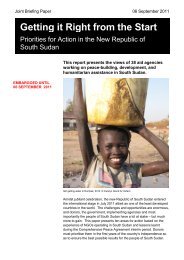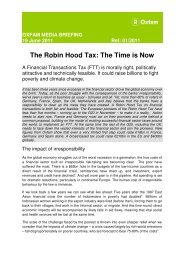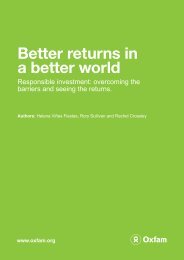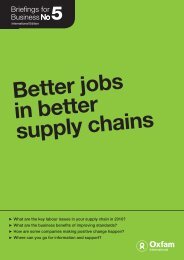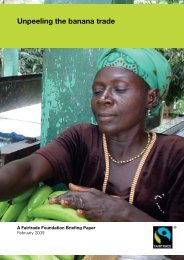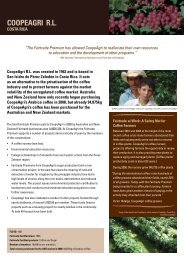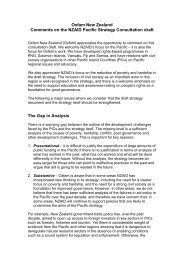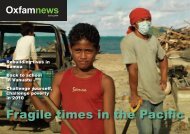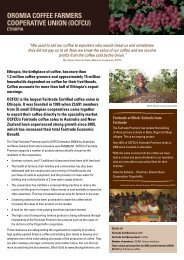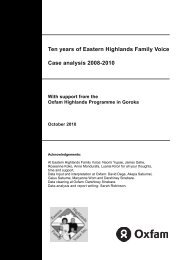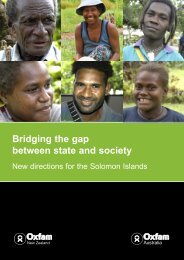Growing a Better Future - Oxfam International
Growing a Better Future - Oxfam International
Growing a Better Future - Oxfam International
- No tags were found...
You also want an ePaper? Increase the reach of your titles
YUMPU automatically turns print PDFs into web optimized ePapers that Google loves.
Large-scale agriculture also has a role to play in meetingthe sustainable production challenge. It is better able tomeet the exacting standards that have come tocharacterize the food supply chains that feedburgeoning cities. Moreover, as economic developmenttakes place, and labour costs rise relative to capitalcosts, larger, more mechanized modes of productionbecome more viable, in turn providing an exit fromagriculture for poor rural people as long as sufficientjobs are created in industry.It is certainly not the case that big is bad. Whether a farmis ‘bad’ or not depends upon the practices of the farmeror company running it – these can be exploitative andenvironmentally destructive whether the farm is twohectares or 20,000 hectares.Nor is it a case of ‘big is beautiful’. Exporting the Brazilianmodel to Africa combines bad economics with adetachment from social reality, and is a prescription forincreased poverty and hunger.A simple thought experiment demonstrates why. Thereare around 33 million small farmers in sub-SaharanAfrica working plots with an average size of 1.6 hectares– a bit larger than 3 American football fields. 136 In Brazil’sCerrado region, a not untypical farm is in excess of20,000 hectares. 137 Put differently, a single large-scalefarm imported from Brazil into Tanzania could displace12,500 smallholder farms. In the absence of anunprecedented and implausible level of job creation inurban centres, the transition to ‘big’ agriculture would beanything but ‘beautiful’ – it would deliver a dramaticincrease in poverty, rural hunger, and urban slums.Moreover, today’s large farms tend to suffer from a heavyecological footprint – due to profligate water use,pollution of groundwater, and reliance on oil-basedagro-chemicals and diesel-burning machinery – thusundermining the human and natural resources on whichfood production must depend.If we are to meet the three challenges set out in theprevious section, then sustainable models of smallholderproduction must be where the lion’s share of effort goes.The huge untapped potential to increase yields amongsmallholder farmers is where the real opportunity lies.And while less input-intensive, more climate-friendlyagricultural practices are not exclusive to small farmers,they are often well suited to this scale of production,and easily adopted (see Box 10).Because vulnerability, poverty and hunger areconcentrated among the rural poor, investing insmallholder agriculture will build resilience, and boostincomes and food availability in hunger hotspots,especially if the investment is sensitive to genderinequalities. 138 Furthermore, history shows that investingin agriculture has provided a crucial ‘growth spark’ in thetake-off of most successful developing economies. 139Box 10: ‘Sustainable intensification’Agriculture will have to become less input-intensiveand wasteful if the resilience challenge is to be met.Clues as to how this can be achieved lie in a toolkitof practices known as ‘sustainable intensification’.Use of animal and green manure reduce dependencyon expensive inorganic fertilizers, the price of which islinked to oil. Agro-forestry and intercropping withleguminous vegetables helps improve soils anddiversify income. Integrated pest managementtechniques reduce the need for expensive chemicalpesticides. Water harvesting reduces the need forirrigation and helps deal with unpredictable rainfall.Soil conservation techniques maintain soil nutrientsand productivity.Recent research into these practices has producedexciting results. The most comprehensive studyexamined 286 sustainable agriculture projects in 57countries and found an average yield increase of 79per cent. 140 Another study reviewing 40 sustainableintensification projects in 20 African countries foundthat average yields more than doubled over a periodof 3–10 years. 141Precisely because these practices were developedfor farmers without access to inputs and machineryand for contexts where conservation of the naturalresource base is critical, they have a much lighterecological footprint. Use of fossil fuel-basedagrochemicals and diesel-burning machinery is low;carbon stocks – above and below ground – can beconserved or even increased; and water and soilsare used more efficiently and sensitively.A good example is the System of Rice Intensification(SRI), a low external input approach widely adoptedby farmers in India, Indonesia and Viet Nam. It wasdeveloped for small farmers to help them boostproductivity and reduce reliance on inputs, andpromoted by <strong>Oxfam</strong> and other NGOs in a growingnumber of countries around the world. The results arestartling: studies across eight countries found averageyield increases of 47 per cent and average reductionsin water use of 40 per cent. This, coupled withreduced use of seeds, synthetic fertilizers, pesticides,and herbicides, allowed farmers to increase theirincomes by over 68 per cent on average, whilesignificantly reducing methane emissions – one ofthe most powerful greenhouse gases. 142<strong>Growing</strong> a <strong>Better</strong> <strong>Future</strong>Chapter 3: The new prosperity53



